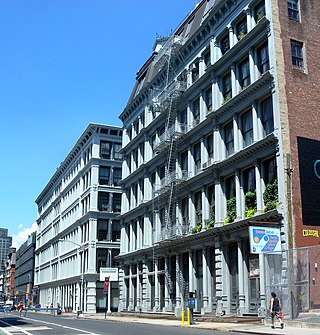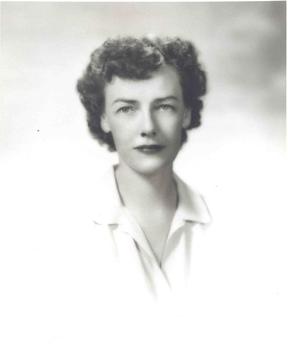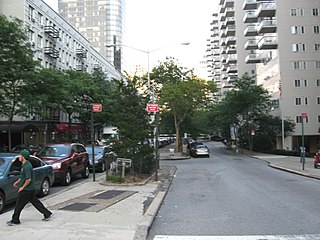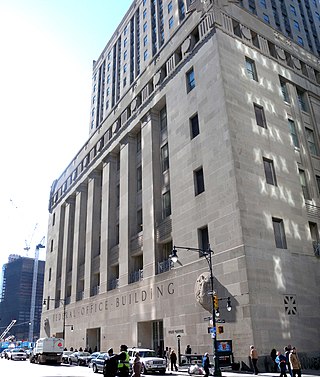
SoHo, sometimes written Soho, is a neighborhood in Lower Manhattan, New York City. Since the 1970s, the neighborhood has been the location of many artists' lofts and art galleries, and has also been known for its variety of shops ranging from trendy upscale boutiques to national and international chain store outlets. The area's history is an archetypal example of inner-city regeneration and gentrification, encompassing socioeconomic, cultural, political, and architectural developments.

Rockefeller Center is a complex of 19 commercial buildings covering 22 acres (89,000 m2) between 48th Street and 51st Street in the Midtown Manhattan neighborhood of New York City. The 14 original Art Deco buildings, commissioned by the Rockefeller family, span the area between Fifth Avenue and Sixth Avenue, split by a large sunken square and a private street called Rockefeller Plaza. Later additions include 75 Rockefeller Plaza across 51st Street at the north end of Rockefeller Plaza, and four International Style buildings on the west side of Sixth Avenue.

The Financial District of Lower Manhattan, also known as FiDi, is a neighborhood located on the southern tip of Manhattan in New York City. It is bounded by the West Side Highway on the west, Chambers Street and City Hall Park on the north, Brooklyn Bridge on the northeast, the East River to the southeast, and South Ferry and the Battery on the south.

Turtle Bay is a neighborhood in New York City, on the east side of Midtown Manhattan. It extends from roughly 43rd Street to 53rd Street, and eastward from Lexington Avenue to the East River's western branch. The neighborhood is the site of the headquarters of the United Nations and the Chrysler Building. The Tudor City apartment complex is next to the southeast corner of Turtle Bay.

Fort Tryon Park is a public park located in the Washington Heights and Inwood neighborhoods of the borough of Manhattan in New York City. The 67-acre (27 ha) park is situated on a ridge in Upper Manhattan, close to the Hudson River to the west. It extends mostly from 192nd Street in the south to Riverside Drive in the north, and from Broadway in the east to the Henry Hudson Parkway in the west. The main entrance to the park is at Margaret Corbin Circle, at the intersection of Fort Washington Avenue and Cabrini Boulevard.

Downtown Brooklyn is the third largest central business district in New York City, and is located in the northwestern section of the borough of Brooklyn. The neighborhood is known for its office and residential buildings, such as the Williamsburgh Savings Bank Tower and the MetroTech Center office complex.

Abigail Aldrich Rockefeller Mauzé was an American philanthropist. She was the daughter of American philanthropists John D. Rockefeller Jr. and Abby Aldrich Rockefeller as well as a granddaughter of Standard Oil co-founder John D. Rockefeller.

The building form most closely associated with New York City is the skyscraper, which has shifted many commercial and residential districts from low-rise to high-rise. Surrounded mostly by water, the city has amassed one of the largest and most varied collection of skyscrapers in the world.

The Dunbar Apartments, also known as the Paul Laurence Dunbar Garden Apartments or Dunbar Garden Apartments, is a complex of buildings located on West 149th and West 150th Streets between Frederick Douglass Boulevard/Macombs Place and Adam Clayton Powell Jr. Boulevard in the Harlem neighborhood of Manhattan, New York City. They were built by John D. Rockefeller Jr. from 1926 to 1928 to provide housing for African Americans, and was the first large cooperative aimed at that demographic. The buildings were designed by architect Andrew J. Thomas and were named in honor of the noted African American poet Paul Laurence Dunbar.

Paley Park is a pocket park located at 3 East 53rd Street between Madison and Fifth Avenues in Midtown Manhattan, New York City, on the former site of the Stork Club. Designed by the landscape architectural firm of Zion Breen Richardson Associates, it opened May 23, 1967. Paley Park is often cited as one of the finest urban spaces in the United States.

66th Street is a crosstown street in the New York City borough of Manhattan with portions on the Upper East Side and Upper West Side connected across Central Park via the 66th Street transverse. West 66th Street is notable for hosting the Lincoln Center for the Performing Arts between Broadway and Columbus Avenue.

The Harlem River Houses is a New York City Housing Authority public housing complex between 151st Street, 153rd Street, Macombs Place, and the Harlem River Drive in the Harlem neighborhood of Manhattan in New York City. The complex, which covers 9 acres (3.6 ha), was built in 1936-37 and opened in October 1937 – one of the first two housing projects in the city funded by the Federal government – with the goal of providing quality housing for working-class African Americans. It has 574 apartments.

The E. V. Haughwout Building is a five-story, 79-foot-tall (24 m) commercial loft building in the SoHo neighborhood of Manhattan, New York City, at the corner of Broome Street and Broadway. Built in 1857 to a design by John P. Gaynor, with cast-iron facades for two street-fronts provided by Daniel D. Badger's Architectural Iron Works, it originally housed Eder V. Haughwout's fashionable emporium, which sold imported cut glass and silverware as well as its own handpainted china and fine chandeliers, and which attracted many wealthy clients – including Mary Todd Lincoln, who had new official White House china painted here. It was also the location of the world's first successful passenger elevator.

Founder's Hall was the first building built on the campus of Rockefeller University at 66th Street and York Avenue, in Manhattan, New York City. Built between 1903 and 1906, it represents an instance of one of John D. Rockefeller's largest scale efforts at philanthropy, and housed the nation's first major biomedical research laboratory. Construction costs for Founders, which included an Animal housing facility and a powerhouse were $276,000. It was declared a National Historic Landmark in 1974. The building is now mainly used for school offices.

Church Street and Trinity Place form a single northbound roadway in Lower Manhattan, New York City. Its northern end is at Canal Street and its southern end is at Morris Street, where Trinity Place merges with Greenwich Street. The dividing point is Liberty Street.

Village Preservation is a nonprofit organization that advocates for the architectural preservation and cultural preservation in several neighborhoods of Lower Manhattan in New York City. Founded in 1980, it has advocated for New York City designated landmark status for a variety of sites like the Stonewall Inn and Webster Hall. The organization and its Executive Director, Andrew Berman, have been described as influential in New York real estate, while some of its activities to prevent development and to support restrictive zoning have attracted criticism.

The South Village is a largely residential area that is part of the larger Greenwich Village in Lower Manhattan, New York City, directly below Washington Square Park. Known for its immigrant heritage and bohemian history, the architecture of the South Village is primarily tenement-style apartment buildings, indicative of the area's history as an enclave for Italian-American immigrants and working-class residents of New York.

Sutton 58 is a residential skyscraper in the Sutton Place neighborhood of Midtown East, Manhattan in New York City.

270 Park Avenue, also known as the JPMorgan Chase Building, is a skyscraper under construction in the Midtown Manhattan neighborhood of New York City. Designed by the firm of Foster + Partners, the tower is expected to rise 1,388 feet (423 m) when it is completed in 2025.

Manhattan Place is a 35-story apartment building at 630 First Avenue in the Murray Hill neighborhood of Manhattan in New York City. Opened in 1984, it was one of the city's first high-rise condominiums and the first project in the city for which Costas Kondylis received credit as the design architect.


























